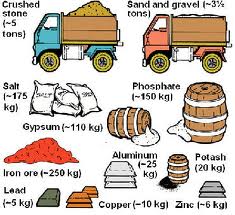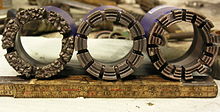Every cellphone uses 42 different minerals in the manufacturing process. This includes bauxite, beryllium, copper, gold, iron, limestone, silica, silver, talc, wollastonite and many rare earths.
Every digital alarm clock contains rare earths in phosphors plus boron, copper, gold and quartz.
Your television contains 35 different minerals, your computer 30.
Today we use silver more in electronics than in jewellery.
Every year 51% of all the copper consumed in the United States goes into house construction.
And a final example, one Toyota Prius motor and battery require 23 kilograms (50 pounds) of rare earths.
Are we running out of mineral resources? No. What we are running out of is easily accessible ones. We’ve managed to find over the last 10,000 years, and particularly in the last 200 years all the low-hanging fruit, to borrow an agricultural term.
In the 21st century we no longer walk along the edge of cliff or a long a river’s edge and strike gold, nickel, iron, or zinc. Today we deploy sophisticated discovery technologies to help find what remains hidden beneath the surface of the Earth. The demand for minerals takes us to the sea floor, the Arctic and other remote areas that are environmentally sensitive or, for the purposes of extraction, technologically challenging.
Demand for Minerals of All Kinds Continues to Climb
In this section we have compiled two lists. One contains mining statistics on the most recognizable mineral resources. The second contains rare earth minerals.
Humanity mines a staggering amount of mineral wealth from the planet each year. These 2010 statistics (unless otherwise indicated) reveal just how much we extract:
- Bauxite – 177,000,000 metric tons (2006)
- Beryllium – 190 metric tons
- Copper – 16,200,000 metric tons
- Gold – 2,500 metric tons
- Iron – 1,600,000,000 metric tons (2009)
- Lead – 4,100,000 metric tons
- Magnesium – 5,580,000 metric tons
- Molybdenum – 234,000 metric tons
- Nickel – 1,445,600 metric tons
- Palladium – 197 metric tons
- Platinum – 183 metric tons
- Silver – 22,200 metric tons
- Titanium – 6,300,000 metric tons
- Uranium – 53,600 metric tons
- Zinc – 12,000,000 metric
Our second list assigns different rare earths to different manufactured products of our Industrial Age. Rare earths have been used in manufacturing since the first incandescent lightbulb. Today you find them in flat screen televisions, cellphones, wind turbines, airplanes, automobiles and satellites. Here’s a sample of where, how and how much we use annually:
- 48,000 metric tons of rare earths are used in permanent magnets including Neodymium, Praseodymium, Dysprosium, Terbium, and Samarium.
- 35,000 metric tons get used in Nickel Metal Hydride Batteries including Lanthanum, Cerium, Praseodymium, and Neodymium.
- 28,500 metric tons are used to make catalytic converters containing Cerium, Lanthanum, Praseodymium, and Neodymium.
- 13,000 metric tons are used in flourescent lightbulbs and paints including Europium, Yttrium, Terbium, Lanthanum, Dysprosium, Cerium, Praseodymium, and Gadolinium.
- 30,500 metric tons are used in polishing powders for the finishing of jewellery, marble, ceramics and other products. These rare earths include Cerium, Lanthanum, and Neodymium.
- 11,000 metric tons are added to glass including Cerium, Lanthanum, Neodymium, Erbium, Gadolinium, and Ytterbium.
Between the minerals on these two lists, when we add the numbers up we can see just how huge a part minerals play in our technology-based society. In fact, on average, per capita use of newly mined minerals in the United States in 2010 amounted to 7,400 kilograms (almost 17,000 pounds).

Keeping Up with Mineral Demand is Getting Tougher
Discovering a mother lode in the past was often accidental. I remember the story told to us in high school about the discovery of the vast deposit of nickel and copper in Sudbury, Ontario in the 19th century. During survey work in Northern Ontario associated with the building of the new Canadian Pacific Railroad a worker noted a deflection on a compass needle when in the Sudbury area. Years later when the railway was under construction copper and nickel surface samples were unearthed. Eventually the area was opened to mining and today, Sudbury represents one of the richest sources of nickel and copper on Earth.
Mineral deposits are seldom found through surface surveys anymore. Instead we rely on a range of technologies to uncover hidden resources. These include remote sensing technologies such as:
- Ground and Aerial Magnetic Surveys – measure the magnetic intensity of an ore body close to the surface of the earth.
- Gravimetric Surveys – study individual geological structures where an overlay of sedimentary rocks hides a potential ore body discovery.
- Electromagnetic Surveys – measure the electromagnetic properties of hidden ore bodies to determine their mineral properties.
- Radiometric Surveys – detect and map radioactive materials such as uranium, thorium, potassium and rare earths.
- Resistivity Surveys – involves transmitting a current into the ground to detect subsurface hydrogeology and ore bodies.
- Audio Frequency Magnetic Surveys – measure natural alternating magnetic fields using sound.
- Ground Penetrating Radar – is used to some degree for mineral exploration but more for mining development to establish bedrock depth, location of sand and gravel deposits, and assess the stability and quality of rock formations.
- Neutron Activation Analysis – can be used in a laboratory or on location to detect halogens, antimony, rare earth elements, gold, platinum, uranium, and thorium in rock samples.
- Seismic Reflection – uses seismic feedback from controlled explosions or other vibration sources to map underground features.

Other techniques involve on site exploration teams of geologists, engineers, botanists, chemists and mining specialists. Techniques deployed include:
- Geochemical Prospecting – can be strategic covering thousands of square kilometers or tactical involving smaller areas with high mineral potential. The chemistry of the rock and soil are measured looking for a halo effect of trace mineral elements. Sampling is mapped to a grid to display geochemical concentrations of mineral elements.
- Geobotanical Prospecting – is a form of geochemical prospecting that identifies plant species known to co-exist with chemicals associated with mineral elements or measures the trace-element content of plants within a strategic or tactical area. Patterns are detected to outline dispersion from a central mineral source.
- Trenching and Sampling – done on site following positive results from remote sensing, geochemical and geobotanical prospecting. Just as it sounds, trenching involves digging a shallow trench in identified tactical areas to collect samples of underlying rocks for testing.
- Core Drilling – is used to identify minerals by analyzing samples from drilling activity. Drilling is also done within mines to test the quality of potential mineral seams.

In our next blog we will look at mineral extraction technologies being deployed in the 21st century.







